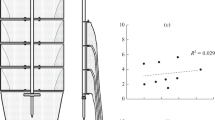Abstract
The vertical distribution of the planktonic larvae of Mesochaetopterus sagittarius (Claparède, 1870) has been studied on the basis of samples taken with closing nets every 3 or 4 h, for periods of at least 24 h. The daily migration does not show the typical pattern. In the evening, the larvae begin to descend from the surface layer; they reach a maximum depth around midnight. The subsequent ascent ends at about noon, when the concentration again attains its maximum close to the surface. The biometric analysis of the samples shows that the migration range depends on the size of the larvae: the bigger they are, the higher is the respective amplitude of migration. Furthermore, there exists a size gradient independent of the time of capture which is most distinct during night time; at night, average size, as well as total number of larvae, decrease in the surface layer and, accordingly, increase in the greater depths. The techniques used allow a high degree of significance to be attached to the results obtained. The standard deviation calculated for each sampling series is lower when two parallel samples are taken at each depth, and in the same water mass, by using a parachute drogue set at 20 m depth and followed during the series.
Résumé
-
1.
L'étude quantitative des séries de 4 prélèvements horizontaux, échelonnées sur plus de 24 h, montre une nette variation de la répartition verticale des larves de Mesochaetopterus sagittarius (Claparède, 1870), en fonction de l'heure.
-
2.
Cette variation n'est pas classique. Les larves sont plus nombreuses pendant le jour, en surface qu'en profondeur, et cette disposition s'inverse durant la nuit.
-
3.
L'analyse qualitative permet de mettre en évidence une migration différentielle, fonction de la taille des individus. Les larves de grande taille ont une amplitude de migration très prononcée.
-
4.
La taille moyenne des larves et leur nombre diminuent pendant la nuit en surface, et corrélativement augmentent en profondeur.
-
5.
Il existe, quelle que soit l'heure de prélèvement un gradient de taille des larves, croissant de la surface vers la profondeur. Ce gradient s'accusse pendant la nuit.
-
6.
Les conditions techniques de pêche ont une importance majeure dans la dispersion des résultats. L'écart type de la distribution du nombre de larves récoltées dans les différentes séries de prélèvements est le plus faible lorsque les prélèvements sont doublés à chaque profondeur de pêche et effectués dans la même masse d'eau en utilisant une drogue à courant.
-
7.
L'analyse qualitative des prélèvements au niveau du fond, ajoutée aux données biologiques déjà acquises, permet un contrôle efficace de la marche des engins de pêche, en particulier de la «luge à plancton».
-
8.
Plusieurs séries de traits horizontaux nécessaires pour l'analyse verticale des masses d'eau sont effectuées dans un court espace de temps. Cependant, à l'opposé des séries de traits verticaux, elles permettent rarement d'obtenir une représentation qualitative et quantitative fidèle d'une même population.
Similar content being viewed by others
Littérature citée
Bhaud, M.: Evolution des populations méroplanctoniques de larves de Mesochaetopterus sagittarius (Claparède, 1870) à Nosy-Bé (Madagascar). Vie Milieu. (1969 a) (sous presse).
Bhaud, M.: Remarques systématiques et biogéographiques sur le genre Mesochaetopterus Potts 1914. Vie Milieu (1969b) (sous presse).
Bliss, C. I.: Periodic regression in biology and climatology. Bull. Conn. agric. exp. Stn. 615, 1–55 (1958).
Bogorov, B. G.: Peculiarities of diurnal vertical migrations of zooplankton in Polar Seas. J. mar. Res. 6, 25–32 (1946).
Cushing, D. H.: The vertical migration of planktonic crustacea. Biol. Rev. 26, 158–192 (1951).
Hardy, A. C. and R. Bainbridge: Experimental observations on the vertical migrations of plankton animals. J. mar. biol. Ass. U.K. 33, 409–448 (1954).
Hure, J.: Migration journalière et distribution saisonnière verticale du zooplancton dans la région profonde de l'adriatique. Acta adriat. 9, 1–60 (1961).
King, J. E. and T. S. Hida: Variations in zooplankton abundance in Hawaiian waters. 1950–52. U.S. Department of the Interior. Spec. scient. Rep. U.S. Fish Wildl Serv. (Fisheries) No. 118 (1954).
Legand, M.: Variations diurnes du zooplancton autour de la Nouvelle Calédonie. Rapp. scient. Inst. fr. Océanie 6, 1–65 (1958).
McLaren, I. A.: Effects of temperature on growth of zooplankton and the adaptative value of vertical migration. J. Fish. Res. Bd Can. 20, 685–727 (1963).
Petit, D.: Essai sur une méthode quantitative. Premières données écologiques sur le genre Lucifer au voisinage de Nosy-Bé. In: Rapport de stage, pp 1–60. Paris: Office de la Recherche Scientifique et Technique Outre-Mer 1968.
Rose, M.: Contributions à l'étude de la biologie du plankton. Le problème des migrations verticales journalières. Archs Zool. exp. gén. 64, 387–542 (1925).
Russell, F. S.: The vertical distribution of marine macroplankton. An observation on diurnal changes. J. mar. biol. Ass. U.K. 13, 769–809 (1925).
—: The vertical distribution of marine macroplankton. 4. The apparent importance of light intensity as a controlling factor in the behaviour of certain species in the Plymouth area. J. mar. biol. Ass. U.K. 14, 415–440 (1926).
—: The vertical distribution of marine macroplankton. 5. The distribution of animals caught in the ring trawl in the day time in the Plymouth Area. J. mar. biol Ass. U.K. 14, 557–608 (1927a).
—: The vertical distribution of plankton in the sea. Biol. Rev. 2, 212–262 (1927b).
Sollberger, A.: Biological rhythm research, 461 pp. London: Elsevier Publishing Co. 1965.
Spooner, G. M.: Observations on the reactions of marine plankton to light. J. mar. biol. Ass. U.K. 19, 385–438 (1933).
Tregouboff, G. et M. Rose: Manuel de planctonologie méditerranéenne. 1, 590 pp. Paris: Centre National Recherche Scientifique 1957.
Author information
Authors and Affiliations
Additional information
Communicated by J. M. Peres, Marseille
Rights and permissions
About this article
Cite this article
Bhaud, M. Etude de la migration verticale quotidienne des larves de Mesochaetopterus sagittarius à Nosy-Bé (Madagascar). Mar. Biol. 4, 28–35 (1969). https://doi.org/10.1007/BF00372163
Accepted:
Issue Date:
DOI: https://doi.org/10.1007/BF00372163




